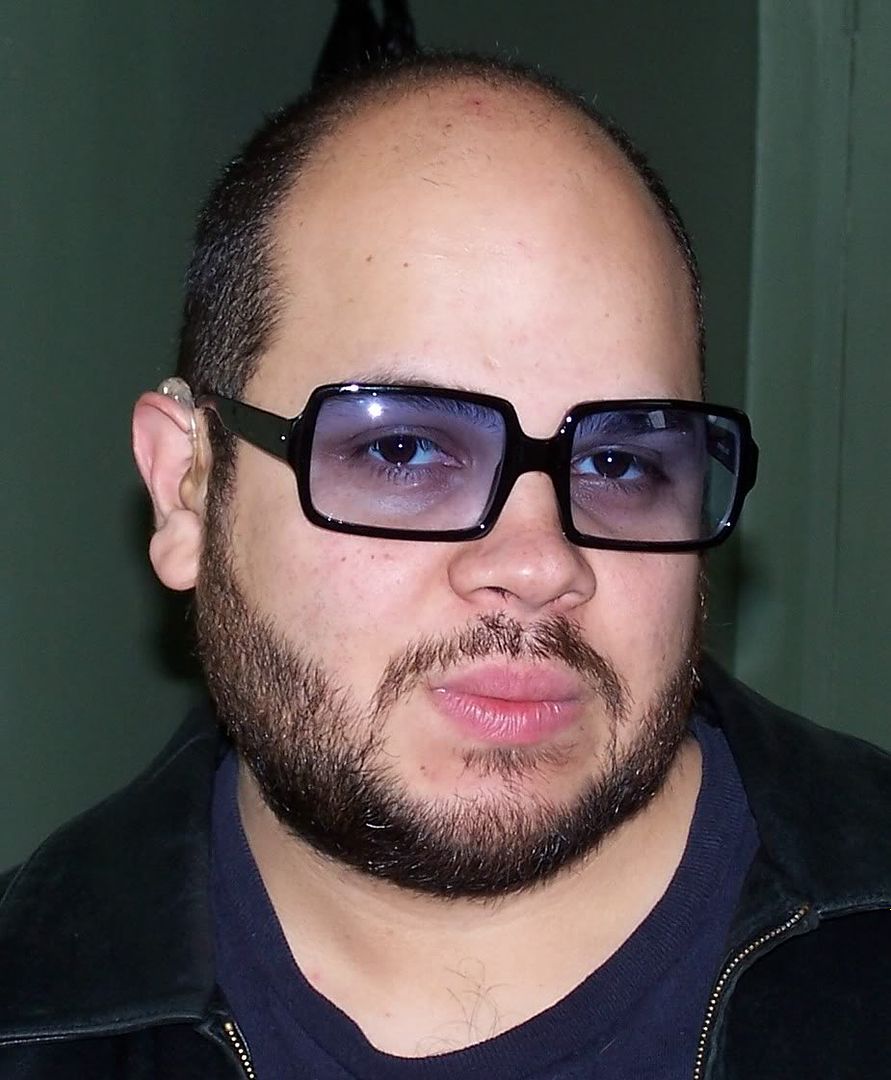Thursday, October 13, 2005
Gay Flag Colors
I thought I'd do a follow up from the National Coming Out Day in regards to the colors of flags seen in the gay communities.

Just about anyone can identify the flag above being associated with the GLBTiQ identity, pride and community. You're bound to see this in all GLBT stores. You might even have seen them affixed on cars.
Each colors of the rainbow flags represent something:
Red - Life
Orange - Healing
Yellow - Sun
Green - Nature
Royal Blue - Harmony
Violet - Spirit
Once in a while you might see a black bar below the violet bar. This represents AIDS awareness.
Most of the time, you'll see the flag displayed with red at the top. Sometimes, you'll see violet at the top. Which side is the right way? Neither, according to the rainbow flag creator, Gilbert Baker. Baker created this flag in 1978. The rainbow flag originally had 8 colors, with hot pink, being first and turquoise, above indigo (this was later changed to royal blue). Pink represented sexuality and turquoise represented art.
As a side note, the Greek letter, lambda (lower case) is often associated with the GLBTiQ communities. The lambda is often colored lavender.
The pink triangle is often associated to gay men.
The labrys had once been associated to lesbians and feminism.
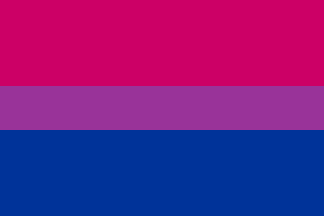
I thought this was interesting, since I don't recall seeing this flag before. This is the BiPride flag. This was created in 1998 by Michael Page. The colors are magneta, lavender and royal blue. If you mix pink and blue, you get purple.
The BiPride group have adopted the trillium as their symbol.
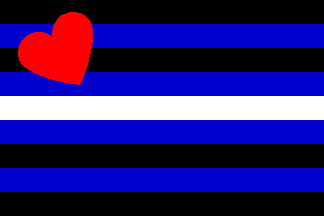
(Some leather pride flags have a wider white bar.)
The Leather Pride flag was created in 1989 by Tony DeBlase, during the 20th anniversary of the Stonewall Riot. Emphasis is stressed that this is not a gay flag but for those who enjoy leather, Levi's, S&M, rubber and fetishes. Despite the emphasis, this flag still seems to be closely associated with the gay communities.
DeBlase did not offer representation for each of the color. Over time, black came to represent leather and permanence, blue for devotion and loyalty, white for purity and innocence and the red heart for love of each other and the community. Some have say that blue is for blue jeans and white is for safety.
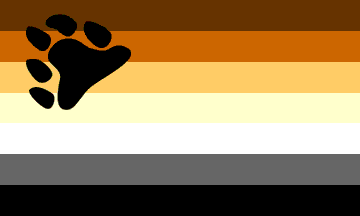
This is the International Bear Brotherhood flag. The seven colors (brown, light brown, very light brown, white, gray and black) represents the colors found on furs of bears. The bear pawprint represents friendship. This flag was created by Byrnes Craig and became official in 1995.
There is a variety of bear pride flags around the world. Thus, calling the flag above the international bear flag.
Bears are gay men who are hirsute (hairy). However, there are different terms applied to men who are hairier or less hairy and/or have different body shapes. Such terms are grizzly, cub, otter, cat and other such terms. Bear chasers are men (usually non-hairy) who go after hairy men.
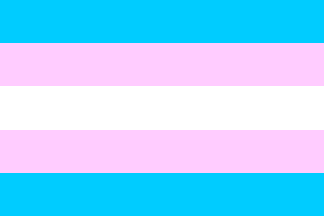
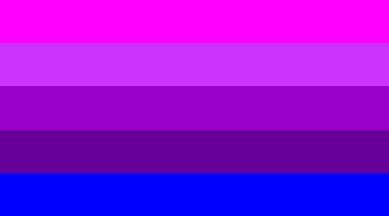
These 2 flags represent the transgendered, which can also include transvestites and transsexuals.
The first flag was created by Monica Helms. The colors are baby blue, pale pink and white.
The second flag was created by Jennifer Pellinen. The flag contains a range of colors from pink to blue. This flag shows the transition from female to male. It can be inverted to show the male to female transition.
Neither flag has been officially adopted.
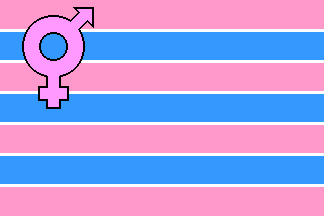
This is the transsexual flag. There is not much information on this flag other than the blue and pink colors, representing male and female.
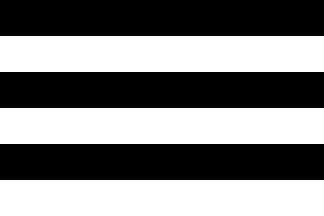
I thought this was hilarious. This has been proposed to be the heterosexual flag. You'll notice that it is absent of colors.
Ah, ta ta for now...
|

Just about anyone can identify the flag above being associated with the GLBTiQ identity, pride and community. You're bound to see this in all GLBT stores. You might even have seen them affixed on cars.
Each colors of the rainbow flags represent something:
Red - Life
Orange - Healing
Yellow - Sun
Green - Nature
Royal Blue - Harmony
Violet - Spirit
Once in a while you might see a black bar below the violet bar. This represents AIDS awareness.
Most of the time, you'll see the flag displayed with red at the top. Sometimes, you'll see violet at the top. Which side is the right way? Neither, according to the rainbow flag creator, Gilbert Baker. Baker created this flag in 1978. The rainbow flag originally had 8 colors, with hot pink, being first and turquoise, above indigo (this was later changed to royal blue). Pink represented sexuality and turquoise represented art.
As a side note, the Greek letter, lambda (lower case) is often associated with the GLBTiQ communities. The lambda is often colored lavender.
The pink triangle is often associated to gay men.
The labrys had once been associated to lesbians and feminism.

I thought this was interesting, since I don't recall seeing this flag before. This is the BiPride flag. This was created in 1998 by Michael Page. The colors are magneta, lavender and royal blue. If you mix pink and blue, you get purple.
The BiPride group have adopted the trillium as their symbol.

(Some leather pride flags have a wider white bar.)
The Leather Pride flag was created in 1989 by Tony DeBlase, during the 20th anniversary of the Stonewall Riot. Emphasis is stressed that this is not a gay flag but for those who enjoy leather, Levi's, S&M, rubber and fetishes. Despite the emphasis, this flag still seems to be closely associated with the gay communities.
DeBlase did not offer representation for each of the color. Over time, black came to represent leather and permanence, blue for devotion and loyalty, white for purity and innocence and the red heart for love of each other and the community. Some have say that blue is for blue jeans and white is for safety.

This is the International Bear Brotherhood flag. The seven colors (brown, light brown, very light brown, white, gray and black) represents the colors found on furs of bears. The bear pawprint represents friendship. This flag was created by Byrnes Craig and became official in 1995.
There is a variety of bear pride flags around the world. Thus, calling the flag above the international bear flag.
Bears are gay men who are hirsute (hairy). However, there are different terms applied to men who are hairier or less hairy and/or have different body shapes. Such terms are grizzly, cub, otter, cat and other such terms. Bear chasers are men (usually non-hairy) who go after hairy men.


These 2 flags represent the transgendered, which can also include transvestites and transsexuals.
The first flag was created by Monica Helms. The colors are baby blue, pale pink and white.
The second flag was created by Jennifer Pellinen. The flag contains a range of colors from pink to blue. This flag shows the transition from female to male. It can be inverted to show the male to female transition.
Neither flag has been officially adopted.

This is the transsexual flag. There is not much information on this flag other than the blue and pink colors, representing male and female.

I thought this was hilarious. This has been proposed to be the heterosexual flag. You'll notice that it is absent of colors.
Ah, ta ta for now...
|
